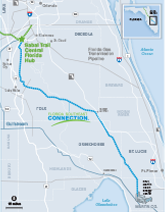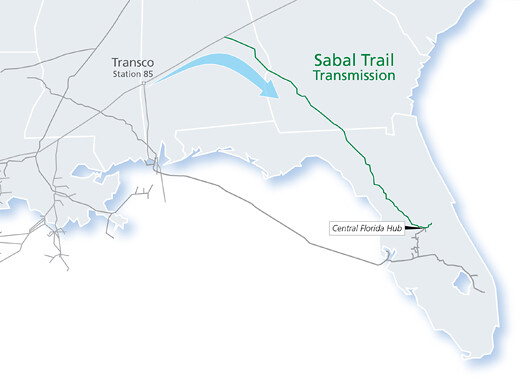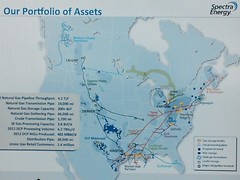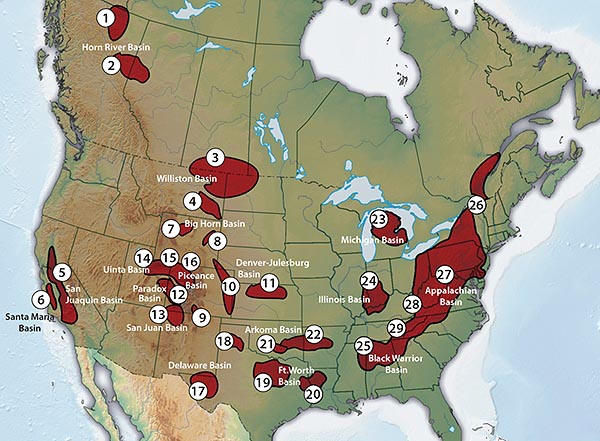French nuclear operator Électricité de France (EDF)
 was denied a license last week for the proposed Calvert Cliffs
nuclear reactor in Maryland, because the
Atomic Energy Act of 1954 prohibits majority foreign ownership
of nuclear plants.
EDF now has 60 days to find a U.S. partner, or give up the project.
Who could the possible suitors be?
Hint: think southeast.
was denied a license last week for the proposed Calvert Cliffs
nuclear reactor in Maryland, because the
Atomic Energy Act of 1954 prohibits majority foreign ownership
of nuclear plants.
EDF now has 60 days to find a U.S. partner, or give up the project.
Who could the possible suitors be?
Hint: think southeast.
The handwriting was on the wall two years ago when
Constellation Energy pulled out of the project.
Jim Polson and Alan Katz wrote for Bloomberg 10 October 2010,
Constellation Drops Nuclear Plant, Denting EDF’s U.S. Plans,
Constellation Energy Group Inc. pulled out of negotiations on a $7.5
 billion loan guarantee to build a nuclear reactor in Maryland with
Electricite de France SA, potentially damaging the French utility’s
U.S. expansion plans and the companies’ partnership.
billion loan guarantee to build a nuclear reactor in Maryland with
Electricite de France SA, potentially damaging the French utility’s
U.S. expansion plans and the companies’ partnership.
The cost of the U.S. government loan guarantee that the companies’
joint venture, UniStar Nuclear Energy, would need to build the
Calvert Cliffs 3 reactor is too high and creates too much risk for
Constellation, the Baltimore-based utility said in a statement
yesterday. The statement said the next step is up to EDF. Enlarge
image U.S. Deputy Energy Secretary Daniel Poneman
In a letter Oct. 8 to Daniel Poneman, deputy secretary of the U.S.
Department of Energy, Constellation said it received a government
estimate that the venture would have to pay about $880 million to
the U.S. Treasury for the loan guarantee, “dramatically out of
line with both our own independent assessments and of what the
figure should reasonably be.”
Constellation’s decision may make it more likely that the U.S.
utility will exercise a put option forcing EDF to buy as much as $2
billion of Constellation’s non-nuclear power plants, said Ingo
Becker, head of utilities sector research at Kepler Capital Markets.
“EDF very clearly said if they exercise the put, this thing is
over,” Becker said. “Constellation may have just turned
around the calendar and pulled out of the new build before
exercising the put, anticipating EDF’s reaction.”
In a letter Oct. 8 to Daniel Poneman, deputy secretary of the U.S.
Department of Energy, Constellation said it received a government
estimate that the venture would have to pay about $880 million to
the U.S. Treasury for the loan guarantee, “dramatically out of
line with both our own independent assessments and of what the
figure should reasonably be.”
Meanwhile, Southern Company
is still trying to reduce what it has to pay for its
$8.3 billion federal loan guarantee.
Back in Maryland, the news got worse for the nuke last year.
EDF
asked for the state’s help,
but didn’t get the answer it wanted.
Scott Dance wrote for Baltimore Business Journal 16 December 2011,
EDF: Constellation-Exelon settlement hurts Maryland nuclear industry,
Continue reading →
 Andrea Grover of Sabal Trail Transmission has been telling Florida
landowners about another proposed pipeline route that completely
bypasses Georgia.
Received yesterday on
Request pipeline town hall –Tim Bland to LCC:
Andrea Grover of Sabal Trail Transmission has been telling Florida
landowners about another proposed pipeline route that completely
bypasses Georgia.
Received yesterday on
Request pipeline town hall –Tim Bland to LCC:
of Georgia (if at all). Why did Sabal change the route? I don’t either. The newspaper is dated October 24, 2013.















